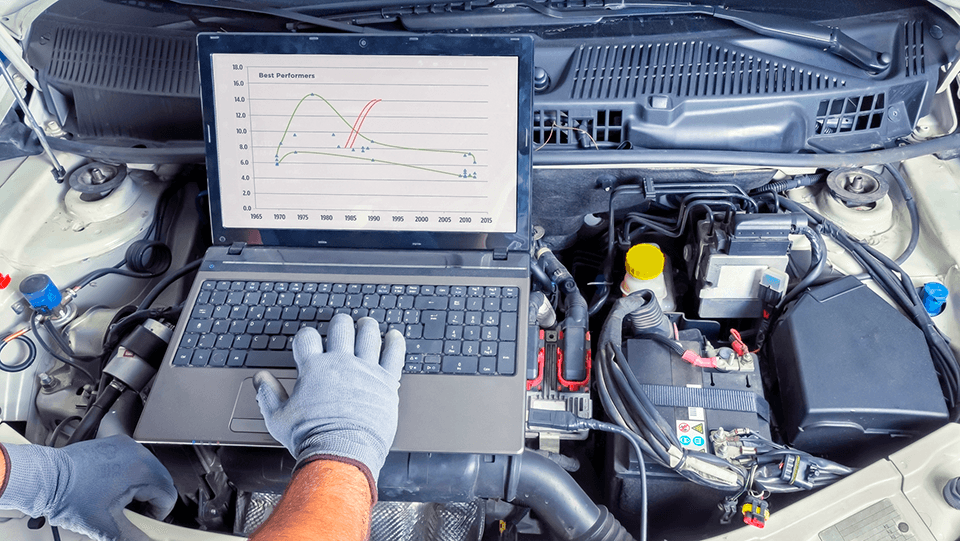The Ultimate Opel Tuning Guide: A Deep Dive into ECU Remaps for OPC, GSi & More

For decades, the Opel badge has been synonymous with robust German engineering and a passionate driving community. From the raw energy of the iconic GSi models to the track-honed precision of the Opel Performance Center (OPC) derivatives, a legacy of performance is encoded in the brand's DNA. Modern Opel vehicles carry this spirit forward, but their true capabilities are often intentionally restrained by the manufacturer. This untapped potential lies dormant within the engine's central computer: the Engine Control Unit (ECU).
The ECU acts as the brain of your Opel's engine, meticulously managing every parameter to meet a broad spectrum of global emissions standards, fuel quality variations, and marketing strategies. To achieve this, factory calibrations are inherently conservative, leaving a significant margin of performance on the table. An Opel ECU remap, or chiptuning, is the definitive process of recalibrating this software to safely unlock the power, torque, and responsiveness that the engineers originally designed into the hardware.
This comprehensive guide serves as the ultimate resource for Opel tuning. We will explore the brand's rich performance history, delve into the science behind a professional ECU remap, analyze the most popular and tunable engines, and provide a clear roadmap of performance stages. Most importantly, we will offer expert guidance on navigating the mechanical limitations of your vehicle to ensure a reliable and exhilarating driving experience. By partnering with a trusted expert like HP Chiptuningfiles, you can transform your Opel from a dependable daily driver into the performance machine it was always meant to be.
2.0 A Legacy of Speed: Understanding Opel's Performance DNA
To fully appreciate the potential of modern Opel tuning, it is essential to understand the brand's storied history of creating factory-built performance vehicles. This legacy provides the context for the engineering and passion that make these cars such a rewarding platform for enhancement.
2.1 The Golden Era of GSi (Grand Sport Injection)
In the mid-1980s, as the hot hatch phenomenon swept across Europe, Opel responded to rivals like the Volkswagen GTI with its own formidable designation: GSi, or Grand Sport Injection. The first models to wear this badge were the Manta GSi and the legendary Kadett E GSi, both initially equipped with a punchy 1.8-litre engine producing 115 hp.
The GSi philosophy was often characterized by an "engine-first" approach. Opel developed some of the most advanced and powerful four-cylinder engines of the era, such as the 2.0-litre 16-valve unit in later Kadett models, which produced up to 156 hp—a figure that often overwhelmed the standard chassis but provided thrilling straight-line performance. This engineering prowess culminated in the South African homologation special, the Kadett "Superboss." Built to dominate Group N racing, its highly-tuned C20XE engine produced 170 hp and held a world record for naturally aspirated torque output per litre until 2009, cementing the GSi's legendary status.
2.2 The Rise of the Opel Performance Center (OPC) and Vauxhall's VXR
In 1997, Opel ushered in a new era of performance with the establishment of the Opel Performance Center (OPC) GmbH, a dedicated in-house tuning division. This marked a significant philosophical shift. While the GSi era often focused on raw engine power, OPC's mission was to develop a more complete and balanced performance package, integrating chassis, braking, and aerodynamic enhancements with potent powertrains.
The first official OPC model was the 1999 Astra G, which was followed by a host of critically acclaimed vehicles, including the Zafira OPC (the world's fastest compact MPV at the time), the Vectra OPC, and the iconic Corsa and Astra OPC hot hatches. These models featured sophisticated technologies like the IDSPlus adaptive chassis with Continuous Damping Control, demonstrating a move towards holistic vehicle dynamics.
For the UK market, Opel vehicles are rebadged as Vauxhall. Consequently, the high-performance OPC models were marketed in the UK under the VXR (Vauxhall Racing) brand, which was launched in 2004. A Vauxhall Astra VXR is, for all tuning purposes, mechanically identical to an Opel Astra OPC.
2.3 From OPC to GSe: The Modern Era
As the automotive industry pivots towards electrification, Opel's performance branding has evolved once more. The OPC nameplate has been succeeded by GSe, which now stands for Grand Sport electric. This new designation signals a future where Opel's performance legacy will be carried forward by advanced hybrid and fully electric powertrains.
3.0 The Science of Opel Chiptuning: How an ECU Remap Works
At the heart of every modern Opel is a sophisticated computer that dictates its performance. Understanding how we interact with this system is the key to appreciating the safety, precision, and effectiveness of a professional ECU remap.
Direct Answer: What is an Opel ECU Remap? An Opel ECU remap, also known as chiptuning, is the process of modifying the software on a vehicle's Engine Control Unit (ECU). This recalibration optimizes key engine parameters like fuel injection, ignition timing, boost pressure, and torque limiters to safely increase horsepower and torque, improve throttle response, and potentially enhance fuel efficiency.
3.1 Deconstructing the ECU: The Brain of Your Opel's Engine
The ECU is a small computer that processes thousands of inputs per second from sensors all over the vehicle—measuring everything from engine speed and throttle position to intake air temperature and oxygen content in the exhaust. Based on this data, it makes real-time decisions to control the engine's operation. Opel vehicles commonly use ECUs from renowned manufacturers like Bosch (e.g., EDC17, ME7.6.2), ACDelco (e.g., E87, E39A), and Delco (e.g., E83). Our engineers have deep expertise in the architecture of each of these systems.
A key reason remapping is so effective is that manufacturers often use a single engine hardware platform for multiple models or trim levels, differentiating their power output purely through software. For example, the 2.0 CDTI ECOTEC engine in the Insignia was offered with power levels ranging from 110 hp to 160 hp. The mechanical components are largely identical and are engineered to handle the highest output. The lower-powered versions are simply "detuned" via the ECU's software. A remap, therefore, is not about pushing the engine into a dangerous, unknown state; it is about optimizing the software to unlock the full potential that the manufacturer themselves engineered into the hardware but restricted for marketing purposes.
3.2 Key Parameters We Modify
A custom tuning file from Chiptuningfiles precisely adjusts several key maps within the ECU's software:
-
Boost Pressure: In turbocharged engines (like the T, Turbo, OPC, or CDTI models), we can safely increase the pressure generated by the turbocharger, forcing more air into the cylinders.
-
Fuel Injection & Air/Fuel Ratio (AFR): To match the increased airflow, we meticulously recalibrate the fuel maps to inject the precise amount of fuel needed for clean, powerful, and safe combustion.
-
Ignition Timing: We optimize the point at which the spark plug ignites the air-fuel mixture. Advancing the timing allows for a more complete combustion process, extracting maximum energy from each power stroke.
-
Torque Limiters: ECUs and Transmission Control Units (TCUs) contain software limiters that cap the engine's torque output. We carefully adjust these limiters to allow the engine to deliver its newly unlocked performance.
3.3 The Benefits: More Than Just Peak Power
While the headline figures are impressive, a professional Opel remap enhances the entire driving experience:
-
Improved Drivability: By creating a wider and flatter torque curve, we deliver stronger acceleration across a much broader portion of the rev range, making the car feel more responsive and effortless in real-world driving.
-
Enhanced Throttle Response: The connection between your right foot and the engine's reaction becomes more immediate and linear, providing a more engaging and confidence-inspiring drive.
-
Potential Fuel Efficiency Gains (Especially for CDTI): For turbo-diesel engines, the significant increase in torque at lower RPMs means the engine doesn't have to work as hard to maintain speed. This allows the driver to use higher gears sooner, which can lead to a 10-15% improvement in fuel economy when driven with a light foot.
4.0 Powerplant Deep Dive: The Most Tunable Opel Engines
Opel has produced a wide range of engines, but a select few have become legendary in the tuning community for their robust construction and incredible performance potential. This section serves as a technical guide to these popular powerplants.
4.1 Petrol Powerhouses
-
The Z20LEH (Astra H OPC/VXR): This 2.0L turbocharged engine is a tuner's dream. Found in the Astra H OPC, it features a durable block and internals capable of handling significant power increases. It is controlled by a Bosch ME7.6.2 ECU, a well-understood platform for remapping. For higher power levels, it's important to monitor the Mass Air Flow (MAF) sensor's limits and ensure the fuel and ignition systems are in perfect health to prevent misfires under high boost.
-
The A20NFT (Astra J OPC/VXR): As the successor to the Z20LEH, this 2.0L engine introduced direct injection (SIDI) technology, offering greater efficiency and precision. Based on the GM LDK Ecotec family, it has excellent tuning potential. As with many direct-injection engines, it can be susceptible to carbon buildup on the intake valves over time. It is also sensitive to boost leaks, which can trigger a P0299 underboost fault code if not addressed.
-
The A16/B16LER (Corsa D/E OPC/VXR): This 1.6L turbo engine turns the Corsa into a true "pocket rocket." However, it has well-documented weak points that must be respected. The stock fuel injectors are known to be undersized and can run at dangerously high duty cycles even on a stock tune, making an injector upgrade a wise move. Early Z16LER engines were also notorious for weak cast pistons, often called "chocolate pistons," making forged internals a near-necessity for anyone targeting significant power gains with a Stage 2 tune or higher. The Corsa D typically uses a Bosch Motronic 7.6.3 ECU, while the Corsa E uses a Delco E83.
-
The A20NHT (Insignia 2.0T): This 2.0L turbo engine, also part of the GM Ecotec family, provides the Insignia with effortless performance. It uses an ACDelco E39A ECU and responds exceptionally well to a Stage 1 remap, delivering a substantial and smooth increase in power. Some early models experienced stuttering under medium load, a condition that can often be resolved with an updated factory or custom software calibration.
4.2 CDTI Diesel Champions
-
The 1.9 CDTI (Z19DTH): Found in many Astra H and Vectra C models, this engine is a reliable workhorse. It was offered in 8-valve (120 hp) and 16-valve (150 hp) versions. The 8-valve is generally considered more robust, as the 16-valve version can suffer from issues with the swirl flaps in the intake manifold failing.
-
The 2.0 CDTI (A20DTH): A staple of the Insignia A and Astra J lineups, this engine is strong and capable of producing over 200 hp with a quality remap. However, it has one critical, well-known weakness: the oil pickup pipe seal in the sump. Over time, this rubber seal can harden and crack, allowing air to be sucked into the oil pump. This leads to oil starvation and, if not caught early, catastrophic engine failure. Replacing this seal is considered essential preventative maintenance for any A20DTH owner, especially before tuning. This engine typically uses a Bosch EDC17C19 or EDC17C59 ECU.
-
The 1.7 CDTI Family (Circle L): These Isuzu-derived engines, with codes like Z17DTH and A17DTJ, are found in countless Astras, Corsas, and Merivas. They are widely regarded for their durability and longevity, making them excellent candidates for a safe and reliable economy or performance tune.
-
The 1.6 CDTI "Whisper Diesel" Family (MGE): This newer generation of diesel engines, found in the Astra K and Insignia B, focuses on efficiency and refinement. Despite their "eco" focus, their advanced turbocharging and common-rail injection systems mean they still offer impressive performance gains from an ECU remap.
5.0 Your Tuning Journey: Opel Performance Stages Explained
Tuning is a journey, not a single event. To help you plan your modifications, the process is typically broken down into "stages," each representing a specific level of hardware and corresponding software calibration.
5.1 Stage 1: The Pure Software Upgrade
A Stage 1 tune is the most cost-effective way to transform your Opel. It involves a high-quality, custom ECU remap with no other hardware modifications required. This single change can safely unlock significant performance gains, typically in the range of 15-25% more power and torque. It is the perfect choice for the daily driver who wants a more responsive and powerful vehicle without compromising reliability.
5.2 Stage 2: Essential Hardware for Serious Gains
Stage 2 is for the enthusiast seeking a higher level of performance. It combines a specially calibrated ECU remap with essential supporting hardware modifications designed to improve the engine's ability to breathe.
-
Required Hardware:
-
High-Flow Exhaust: Replacing the restrictive factory downpipe and catalytic converter (and DPF on diesels) with a larger-diameter, free-flowing system. This reduces exhaust back-pressure and lowers exhaust gas temperatures (EGTs), allowing the turbocharger to work more efficiently.
-
Uprated Intercooler: A larger, more efficient front-mount intercooler is critical for managing intake air temperatures. The factory intercooler can quickly become overwhelmed, leading to "heat soak" and a significant loss of power during spirited driving. An upgraded unit ensures consistently cool, dense air for maximum performance.
-
Cold Air Intake: An improved intake system allows the engine to draw in cooler, denser air more easily, further enhancing efficiency and power.
-
5.3 Stage 3 & Beyond: Forging a Path to Maximum Power
Stage 3 and beyond is the realm of custom builds and maximum performance. This level of tuning is built around major hardware changes, such as a larger hybrid or aftermarket turbocharger, significantly larger fuel injectors, an upgraded high-pressure fuel pump, and, crucially, forged engine internals (pistons and connecting rods) to handle the immense increase in cylinder pressure.
5.4 Performance Gains Tables
The following tables provide a clear overview of the expected performance gains from a Stage 1 and Stage 2 ECU remap on popular Opel OPC/VXR models. Note: Figures are approximate and can vary based on vehicle condition, fuel quality, and dynamometer used.
Table 1: Opel Astra OPC/VXR Performance Gains
|
Model |
Engine |
Stock Power |
Stock Torque |
Stage 1 Gains (HP/Nm) |
Stage 2 Gains (HP/Nm) |
|
Astra H OPC |
Z20LEH |
240 hp |
320 Nm |
+35-50 hp / +80-130 Nm |
+50-60 hp / +130-150 Nm |
|
Astra J OPC |
A20NFT |
280 hp |
400 Nm |
+30-40 hp / +50-70 Nm |
+40-50 hp / +70-90 Nm |
Table 2: Opel Corsa OPC/VXR Performance Gains
|
Model |
Engine |
Stock Power |
Stock Torque |
Stage 1 Gains (HP/Nm) |
Stage 2 Gains (HP/Nm) |
|
Corsa D OPC |
A16LER |
192 hp |
230 Nm |
+23-28 hp / +70-80 Nm |
+45-55 hp / +140-150 Nm |
|
Corsa E OPC |
B16LER |
207 hp |
280 Nm |
+13-23 hp / +60-70 Nm |
+20-30 hp / +70-85 Nm |
Table 3: Opel Insignia Performance Gains (Select Models)
|
Model |
Engine |
Stock Power |
Stock Torque |
Stage 1 Gains (HP/Nm) |
Stage 2 Gains (HP/Nm) |
|
|
Insignia 2.0T |
A20NHT |
250 hp |
400 Nm |
+45 hp / +40-50 Nm |
Requires custom setup |
|
|
Insignia 2.0 CDTI |
A20DTH |
160 hp |
350 Nm |
+40 hp / +70-80 Nm |
Requires DPF/EGR mods |
6.0 Tuning with Intelligence: Navigating Opel's Mechanical Limits
Adding power is only half the equation. A true tuning expert understands the entire vehicle as a system and respects its mechanical limitations. By proactively addressing known weak points, you can enjoy your tuned Opel with confidence and reliability. It is crucial to understand that a quality remap does not cause these components to fail; rather, the increased torque exposes pre-existing wear or design limitations. This knowledge allows you to make informed decisions and budget for necessary supporting upgrades.
6.1 The M32 Gearbox: The 320 Nm Elephant in the Room
Many popular Opel models, including the Astra H/J, Corsa D/E, and Insignia, are equipped with the Getrag M32 6-speed manual gearbox. As its name suggests, this gearbox has a factory-rated maximum torque capacity of 320 Nm. This presents a direct conflict, as many Stage 1 tunes, especially on OPC and CDTI models, can easily produce torque figures between 300 Nm and 350 Nm.
The most common failure point is the 5th/6th gear output shaft bearing. Insufficient lubrication and high torque loads can cause this bearing to wear prematurely, resulting in a distinct whining noise in higher gears and noticeable movement of the gearstick, particularly when accelerating in 1st and 5th gear. To mitigate this known issue, it is highly recommended to use a high-quality 75W-80 gear oil and consider a slight overfill—increasing the fluid from the standard 2.4 litres to 2.7-2.8 litres—to improve lubrication of the upper bearings. For any vehicle undergoing a Stage 2 tune or higher, budgeting for an eventual gearbox rebuild with uprated bearings is a prudent measure.
6.2 Clutch Capacity: The First Drivetrain Fuse
The clutch is designed to be the "fuse" of the drivetrain. The factory-installed clutch is engineered to handle the stock torque output with a small safety margin. A remap that significantly increases torque, particularly the low-RPM torque of a diesel tune, can easily overcome the clutch's clamping force.
This will manifest as clutch slip, where the engine revs climb without a corresponding increase in vehicle speed, most commonly occurring under heavy throttle in higher gears (4th, 5th, and 6th). This is not a fault of the tuning file. It is an indication that the tune has revealed the mechanical limit of a worn or simply under-specified clutch. If your vehicle's clutch is high-mileage or already showing signs of wear, a remap will almost certainly accelerate the need for its replacement. For any Stage 2 or higher build, an uprated performance clutch is essential.
6.3 Automatic Transmissions: The Importance of TCU Tuning
Modern automatic gearboxes are controlled by their own computer, the Transmission Control Unit (TCU), which works in tandem with the engine's ECU. The TCU has its own set of internal torque limiters designed to protect the gearbox components. If you remap the engine for more power but leave the TCU software stock, the gearbox will actively command the engine to reduce torque to stay within its original safe limits, effectively wasting the potential of your engine tune.
A professional TCU tune is essential for any tuned automatic Opel. This recalibration:
-
Increases Torque Limits: The software limits are raised to match the engine's new output.
-
Increases Clutch Pressure: Line pressure is increased, allowing the internal clutch packs to clamp harder and prevent slip under higher torque loads.
-
Optimizes Shift Points: Shift points are adjusted to keep the engine in its new, higher power band for longer, maximizing acceleration.
-
Reduces Shift Times: Gear changes are made faster and more decisively for a sportier feel.
Without a corresponding TCU tune, an engine remap on an automatic Opel will never deliver its full potential.
7.0 The HP Chiptuningfiles Advantage: Precision, Safety, and Performance
In the world of chiptuning, not all files are created equal. The quality of the software uploaded to your Opel's ECU is the single most important factor determining its performance, safety, and reliability. This is where Chiptuningfiles stands apart.
-
Custom, Dyno-Developed Files: We do not sell generic, one-size-fits-all files. Every tuning file we provide has been meticulously developed and tested on a state-of-the-art dynamometer. This process allows us to fine-tune every parameter for optimal performance while respecting the engine's mechanical and thermal safety margins.
-
Deep Expertise with Opel ECUs: Our team of engineers possesses an intimate understanding of the specific ECU systems used by Opel, from Bosch EDC17 and ME7 to ACDelco E83 and E87. We utilize the most advanced professional tuning hardware in the industry, including Alientech KESS3/K-TAG, Autotuner, and BitBox, ensuring a safe and successful flashing process.
-
A Trusted Global Partner: With a network of over 4,000 tuning professionals worldwide, our reputation for quality and reliability is proven. We are the trusted file provider for workshops and dealers who demand the best for their customers.
-
Comprehensive Tuning Solutions: Beyond standard Stage 1 and Stage 2 performance tunes, we offer a range of specialized software solutions, including DPF/EGR off functions for diesel race applications, Vmax (speed limiter) removal, and exciting Pop & Bang maps for applicable petrol models.
Ready to transform your Opel? Create your free account to access our extensive tuning file database and see the potential for your specific model.
8.0 Frequently Asked Questions (FAQ)
Q1: Is remapping my Opel safe for the engine?
A: Yes, when performed by a reputable, professional file provider. Our custom tuning files are developed on a dynamometer to ensure all modifications operate well within the engine's mechanical and thermal safety margins. We build our business on long-term reliability. Furthermore, we provide clear guidance on known mechanical weak points, such as the critical A20DTH oil pickup seal, empowering owners to perform preventative maintenance that ensures the long-term health of their tuned engine.
Q2: How will an ECU remap affect my Opel's fuel economy?
A: The effect on fuel economy depends on the engine type and driving style. For turbo-diesel (CDTI) models, a performance or economy-focused remap can improve MPG by 10-15% during normal driving. This is achieved because the increased low-end torque allows the engine to operate at lower RPMs. For high-performance petrol tunes on OPC/VXR models, fuel consumption will naturally increase during spirited driving. However, during steady-state cruising, fuel economy can remain similar to or even slightly better than stock due to improved engine efficiency.
Q3: What tools are needed to apply a tuning file to my Opel?
A: Applying a tuning file requires professional-grade diagnostic tools. These tools, such as the Alientech KESS3 or K-TAG, Autotuner, or CMD Flash, connect to the vehicle's OBD-II port or, in some cases, directly to the ECU on the bench. They are used to safely read the vehicle's original software and then write the new, modified tuning file. HP Chiptuningfiles provides files that are compatible with all major professional tuning tools on the market.
Q4: Can you remove emissions systems like the DPF or EGR?
A: Yes, we provide software solutions for the correct deactivation of emissions control systems like the Diesel Particulate Filter (DPF) and Exhaust Gas Recirculation (EGR) valve. This is typically required for Stage 2 and higher diesel tunes where the physical hardware has been removed. Our software modifications ensure that no diagnostic trouble codes (DTCs) or "limp mode" issues arise from the hardware removal. Please note, these services are intended strictly for off-road or motorsport use, as removing emissions equipment may not be legal for use on public roads in your country or region.
9.0 Conclusion: Unleash the True Spirit of Your Opel
From the raw, engine-focused thrill of the first GSi to the balanced, track-capable precision of the OPC, Opel has always engineered more performance into its vehicles than what is accessible from the factory floor. Modern ECU remapping is the key that unlocks this heritage. It is the most effective way to elevate your vehicle's performance, refine its drivability, and create a more engaging and responsive connection between driver and machine.
However, achieving a truly exceptional result requires more than just increasing numbers on a screen. It demands a deep understanding of the engine's characteristics, a respect for its mechanical limits, and the expertise to craft a calibration that is both powerful and reliable. Choosing a high-quality, custom-developed tuning file is the single most important decision in your tuning journey.
By choosing HP Chiptuningfiles, you are partnering with a global leader in ECU calibration. Our expertise, commitment to safety, and proven results are why over 4,000 professionals trust us with their clients' vehicles. Your Opel has more to give. Explore our Opel tuning files, check our competitive prices, or contact our expert support team to begin your transformation today.
Other news and updates

Read more OBD Breakthrough: Tuning Support for the Continental ASG1 ECU in Audi e-tron & Porsche Taycan
The Continental ASG1 ECU used in the Audi e-tron and Porsche Taycan is now fully supported for OBD read/write. This breakthrough allows safe tuning of torque limits, current maps, thermal strategies and pedal response, enabling measurable performance gains whi...
Read more

Read more Stage 1, Stage 2, and Stage 3 Tuning: Which One Is Right for You? | HP Chiptuning Files Europe & UK
Discover the differences between Stage 1, Stage 2, and Stage 3 tuning. Learn which remap is best for your car, driving style, and budget at hp-chiptuningfiles.com.
Read more

Read more Mercedes-AMG G63 2025: ECU Remap & Performance Boost
Hey, we are HP Chiptuningfiles – Europe’s leading ECU tuning file service provider. We deliver custom, dyno-tested tuning files for diesel, petrol & hybrid engines, trusted by 4,000+ clients worldwide. The 2025 Mercedes-AMG G63 combines iconic G-Class ruggedne...
Read more